Crash Type Analysis
Provided below are the definitions of the 12 crash types groups included in the PEDSAFE application. These definitions are from the PBCAT software.5 For any crash type, there are multiple problems or possible causes that may have led to the crash. The following section also provides examples of a few possible causes/problems for each crash type and some of the countermeasures within PEDSAFE that may be applicable. At the end of each potential countermeasure is the number in parentheses, which is linked to the countermeasure description. Neither the list of problems and possible causes nor the suggested countermeasures are to be considered comprehensive. Practitioners are required to supplement the analysis and recommendations with their own investigations and knowledge of local policies and practices.
All numbers in parentheses under the Countermeasures heading are linked to the Countermeasure section of the PEDSAFE website.
1. Dart/Dash
The pedestrian walked or ran into the roadway at an intersection or midblock location and was struck by a vehicle. The motorist’s view of the pedestrian may have been blocked until an instant before the impact.
 Pedestrian walking into the roadway at a midblock location and into the path of a vehicle.
Pedestrian walking into the roadway at a midblock location and into the path of a vehicle.
Possible Cause/Problem #1:
Child runs into neighborhood/collector street
-
Candidate Countermeasures:
- Provide adequate nighttime lighting.
- Narrow travel lanes.
- Provide curb extensions.
- Install spot street narrowing at high midblock-crossing locations.
- Implement traffic-calming measures such as chicanes, speed humps, or speed tables.
- Provide a raised pedestrian crossing.
- Design gateway to alert motorists that they are entering neighborhood with high level of pedestrian activity.
- Convert street to driveway link/serpentine, shared street, or a pedestrian street.
- Install street diverters, or full or partial street closures, at selected intersection(s).
- Provide adult crossing guard (in school zone).
- Remove or restrict on-street parking.
- Educate children about safe crossing behavior and adults about speeding.
- Add on-street parking enhancements.
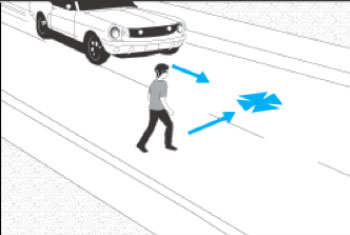 Pedestrian running into the street at a midblock location and into the path of a vehicle.
Pedestrian running into the street at a midblock location and into the path of a vehicle.
Possible Cause/Problem #2:
Pedestrian is struck while crossing a high-speed and/or high-volume arterial street.
-
Candidate Countermeasures:
- Relocate bus stop.
- Improve/add nighttime lighting.
- Install overpass or underpass.
- Install medians or pedestrian crossing islands.
- Provide curb extensions at intersections or midblock to improve direct line of sight between vehicle and pedestrian.
- Add traffic-calming measures.
- Provide staggered crosswalk through the median (forcing pedestrians to walk and look to the right for oncoming traffic in the second half of street).
- Install midblock traffic signal with pedestrian signals, if warranted.
- Install standard warning sign (see MUTCD) or yellow or fluorescent yellow/green signs to alert drivers to pedestrian crossing area.
- Bus young children across busy streets.
- Adjust school district boundaries.
- Use speed-monitoring trailer.
- Enforce speed limits, pedestrian ordinances.
- Implement driver education program.
- Implement pedestrian education program.
2. Multiple Threat/Trapped
The pedestrian entered the roadway in front of stopped or slowed traffic and was struck by a multiple-threat vehicle in an adjacent lane after becoming trapped in the middle of the roadway.
 Pedestrian walking into the roadway, in front of stopped or slowed traffic, and into the path of a vehicle in the adjacent lane.
Pedestrian walking into the roadway, in front of stopped or slowed traffic, and into the path of a vehicle in the adjacent lane.
Possible Cause/Problem #1 (multiple threat):
The pedestrian entered the traffic lane in front of stopped traffic and was struck by a vehicle traveling in the same direction as the stopped vehicle. The stopped vehicle may have blocked the visibility between the pedestrian and the striking vehicle, and/or the motorist may have been speeding.
- Candidate Countermeasures:
- Relocate bus stop to far side of crossing area.
- Improve roadway lighting.
- Provide midblock or intersection curb extensions.
- Install traffic-calming devices such as speed tables or raised pedestrian crossings on local or other neighborhood streets.
- Provide raised crosswalks to improve pedestrian visibility.
- Install traffic signals if warranted, including pedestrian signals.
- Install flashers or advance warning signs.
- Install barriers or signs to prohibit crossings and direct pedestrians to safer crossing locations nearby.
- Enforce crosswalk laws.
- Add on-street parking enhancements.
- Add advance yield/stop lines 20 to 50 feet before intersection.
- Implement driver education program.
- Implement pedestrian education program.
Possible Cause/Problem #2:
Pedestrian is struck while crossing a high-speed and/or high-volume arterial street.
-
Candidate Countermeasures:
- Reduce roadway width. For example, add sidewalks and bike lanes to a roadway by narrowing four-lane undivided roadways to two through lanes, plus a center two-way left-turn lane or wide raised median.
- Improve roadway lighting.
- Construct overpass or underpass.
- Narrow travel lanes (e.g., add bike lanes) to slow vehicle speeds and reduce crossing distance.
- Install raised median or pedestrian crossing island .
- Increase police enforcement of speed limit.
- Add advance yield/stop lines 20 to 50 feet before intersection.
- Install pedestrian hybrid beacon (PHB).
- Install rectangular rapid flash beacon (RRFB).
- Install automated enforcement system.
- Implement driver education program.
- Implement pedestrian education program.
 Pedestrian crossing on the street during a green signal phase and became trapped in the roadway when the signal changed.
Pedestrian crossing on the street during a green signal phase and became trapped in the roadway when the signal changed.
Possible Cause/Problem #3 (trapped):
Pedestrian began crossing on green signal and became trapped in the roadway when the signal changed.
-
Candidate Countermeasures:
- Reduce roadway width.
- Provide midblock or intersection curb extensions.
- Install raised pedestrian crossing island.
- Provide raised crosswalk to improve pedestrian visibility.
- Install pedestrian signals.
- Adjust pedestrian signal timing.
- Enforce crosswalk laws.
- Add leading pedestrian interval to traffic signal system.
- Install push button and adjust signal timing.
- Implement driver education program.
- Implement pedestrian education program.
3. Unique Midblock (Mailbox, Ice Cream Vendor, Parked Vehicle)
The pedestrian was struck while crossing the road to/from a mailbox, newspaper box, ice-cream truck, similar unique/temporary destinations, or while getting into or out of a stopped vehicle.
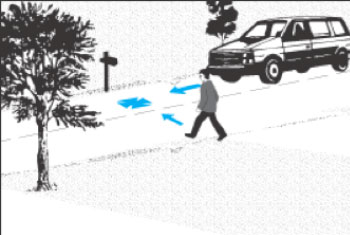 Pedestrian struck while going to/from a private residence mailbox/newspaper box.
Pedestrian struck while going to/from a private residence mailbox/newspaper box.
Possible Cause/Problem #1:
Pedestrian struck while going to/from a private residence mailbox/newspaper box.
-
Candidate Countermeasures:
- Improve lighting.
- Reduce total roadway and lane width.
- Provide raised median on multi-lane arterial street.
- Provide traffic calming measures (e.g., chicanes or raised devices on residential streets).
- Construct gateway or provide signs that identify neighborhood as an area with high levels of pedestrian activity.
- Install pedestrian warning signs (see MUTCD).
- Implement driver education program.
- Implement pedestrian education program.
- Relocate mailboxes to safer crossing area or provide safer crossings at existing location.
- Add on-street parking enhancements.
 Pedestrian struck while going to/from a private residence mailbox/newspaper box.
Pedestrian struck while going to/from a private residence mailbox/newspaper box.
Possible Cause/Problem #2:
Pedestrian struck while going to/from an ice-cream vendor or similar destination.
-
Candidate Countermeasures:
- Reduce roadway width or remove a lane.
- Provide traffic calming measures on local streets.
- Add pedestrian crossing islands to roadway.
- Create Public Service Announcements (PSAs) to educate parents, children, and drivers.
- Adopt an ice-cream truck ordinance. This ordinance would prohibit motorists from passing a stopped ice-cream truck. Trucks would be equipped with flashing lights and a “stop” arm that would extend when the truck stopped to serve children.
- Add on-street parking enhancements.
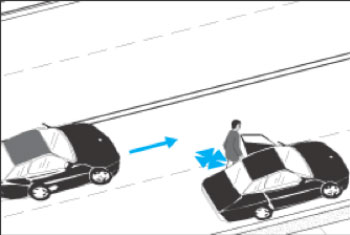 Pedestrian struck while getting into/out of parked vehicle.
Pedestrian struck while getting into/out of parked vehicle.
Possible Cause/Problem #3:
Pedestrian struck while getting into/out of parked vehicle.
-
Candidate Countermeasures:
- Improve roadway lighting.
- Implement traffic-calming measures on local/collector streets.
- Implement speed-reduction measures such as chicanes or speed tables.
- Restrict on-street parking.
- Add on-street parking enhancements.
- Implement driver education program.
- Implement pedestrian education program.
4. Through Vehicle at Unsignalized Location
The pedestrian was struck at an unsignalized intersection or midblock location. Either the motorist or the pedestrian may have failed to yield.
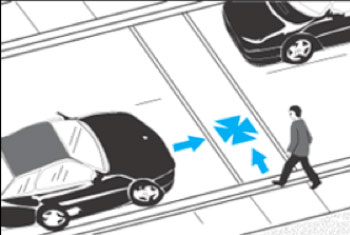 Motorist fails to yield to pedestrian at two-lane, low-speed road crosswalk.
Motorist fails to yield to pedestrian at two-lane, low-speed road crosswalk.
Possible Cause/Problem #1:
Motorist fails to yield to pedestrian at two-lane, low-speed road crosswalk (or unmarked crossing).
- Candidate Countermeasures:
- Improve crosswalk marking visibility.
- Improve roadway lighting.
- Reduce curb radius to slow vehicle speeds.
- Install curb extensions or choker.
- Use special paving treatments along street to slow traffic, add chicanes, or use serpentine design.
- Construct raised pedestrian crossing island.
- Install speed humps, speed tables, raised intersections, or raised crosswalks.
- Use landscaping that slows vehicle speeds without impeding sightlines.
- Install traffic signal with pedestrian signals, if warranted.
- Install overhead CROSSWALK, school zone, or other warning signs.
- Add on-street parking enhancements.
- Add advance yield/stop lines 20 to 50 feet before intersection.
- Implement driver education program.
- Implement pedestrian education program.
Possible Cause/Problem #2:
Pedestrian has difficulty crossing multilane road (which may also have high travel speeds and/or high traffic volumes).
- Candidate Countermeasures:
- Ensure that curb ramps are provided to make crossing easier for all pedestrians.
- Place bus stop at far side of intersection.
- Install nighttime lighting.
- Construct overpass or underpass.
- Narrow or reduce the number of roadway lanes.
- Modify four-lane, undivided street to two lanes plus a two-way, left-turn lane (TWLTL) or wide median with turning pockets.
- Install raised medians or pedestrian crossing islands.
- Install traffic signal with pedestrian signals, if warranted.
- Use police speed enforcement.
- Add advance yield/stop lines 20 to 50 feet before intersection.
- Improve access to transit.
- Provide pedestrian accommodations at complex intersections.
- Install pedestrian hybrid beacon (PHB).
- Install rectangular rapid flash beacon (RRFB).
- Install automated enforcement system.
- Implement driver education program.
- Implement pedestrian education program.
Possible Cause/Problem #3:
Motorist unwilling to yield due to high motorist speeds or high traffic volumes.
- Candidate Countermeasures:
- Improve crosswalk marking visibility.
- Improve roadway lighting.
- Reduce curb radius to slow vehicle speeds.
- Install curb extensions or choker.
- Use special paving treatments along street to slow traffic, add chicanes, or use serpentine design.
- Construct raised pedestrian crossing island.
- Install speed humps, speed tables, raised intersections, or raised crosswalks.
- Use landscaping that slows vehicle speeds without impeding sightlines.
- Install traffic signal with pedestrian signals, if warranted.
- Install overhead CROSSWALK, school zone, or other warning signs.
- Add on-street parking enhancements.
- Add advance yield/stop lines 20 to 50 feet before intersection.
- Implement driver education program.
- Implement pedestrian education program.
5. Bus-Related
The pedestrian was struck by a vehicle while: (1) crossing in front of a public bus stopped at a bus stop; (2) going to or from a school bus stop; or (3) going to or from, or waiting near a public bus stop.
 A pedestrian was struck by a vehicle while crossing in front of a public bus stopped at a bus stop..
A pedestrian was struck by a vehicle while crossing in front of a public bus stopped at a bus stop..
Possible Cause/Problem #1:
Motorist fails to yield to pedestrian or pedestrian crosses during inadequate gap in traffic due to limited sight distance at intersection.
- Candidate Countermeasures:
- Install crosswalk markings to encourage pedestrians to cross in the crosswalk behind the bus.
- Move bus stop to far side of intersection or crosswalk.
- Consider an alternative bus stop location.
- Mark bus stop area with pedestrian warning signs.
- Install or improve roadway lighting.
- Install pedestrian crossing islands or raised crosswalk.
- Install curb extension.
- Remove parking in areas that obstruct the vision of motorists and pedestrians.
- Add advance yield/stop lines 20 to 50 feet before intersection.
- Improve access to transit.
- Install bus bulb-outs.
- Install pedestrian hybrid beacon (PHB).
- Install rectangular rapid flash beacon (RRFB).
- Implement driver education program.
- Implement pedestrian education program.
Possible Cause/Problem #2:
Pedestrian has difficulty walking along roadway and crossing at midblock location with high vehicle speeds and/or high volumes.
- Candidate Countermeasures:
- Provide an accessible sidewalk and curb ramps.
- Install sidewalk and/or sidewalk barriers to direct pedestrians to a nearby crossing location.
- Provide bus pull-off area.
- Consider an alternative bus stop location.
- Install or improve roadway lighting.
- Reduce number of roadway lanes.
- Install midblock curb extensions.
- Install traffic and pedestrian signals, if warranted.
- Add recessed stop lines.
- Provide pedestrian education/training.
- Increase police speed enforcement.
- Add advance yield/stop lines 20 to 50 feet before intersection.
- Improve access to transit.
- Install bus bulb-outs.
- Install pedestrian hybrid beacon (PHB).
- Install rectangular rapid flash beacon (RRFB).
- Implement driver education programs.
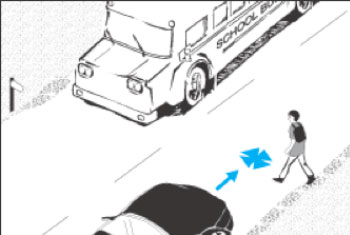 Pedestrian has difficult time crossing, waiting, or walking in the vicinity of school bus stop.
Pedestrian has difficult time crossing, waiting, or walking in the vicinity of school bus stop.
Possible Cause/Problem #3:
Pedestrian has difficult time crossing, waiting, or walking in the vicinity of school bus stop.
- Candidate Countermeasures:
- Provide sidewalks.
- Install or improve roadway lighting.
- Provide street furniture or other amenities at bus stop.
- Relocate school bus stop.
- Implement pedestrian/driver education programs.
- Educate pedestrians to cross behind the bus at far side of bus stops.
- Involve school, neighborhood groups, and PTA in promoting education and enforcement.
- Enforce regulations against passing stopped school bus.
- Improve access to transit.
- Install pedestrian hybrid beacon (PHB).
- Install rectangular rapid flash beacon (RRFB).
6. Turning Vehicle
The pedestrian was attempting to cross at an intersection, driveway, or alley and was struck by a vehicle that was turning right or left.
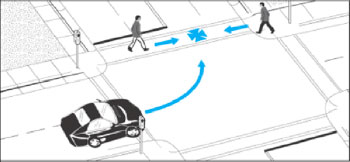 Conflict between pedestrians crossing in a marked crosswalk at an intersection and left-turning vehicle.
Conflict between pedestrians crossing in a marked crosswalk at an intersection and left-turning vehicle.
Possible Cause/Problem #1:
Conflict between pedestrian and left-turning vehicle.
- Candidate Countermeasures:
- Add curb ramps or curb extensions.
- Install raised median and pedestrian crossing island.
- Convert to one-way street network (if justified by surrounding area wide pedestrian and traffic volume study).
- Consider using modified T-intersections, intersection median barriers, diverters, or street closures.
- Use traffic-calming devices, such as a raised intersection or raised pedestrian crossing, to reduce vehicle speeds.
- Provide separate left-turn and WALK/DON’T WALK signals.
- Add special pedestrian signal phasing (e.g., exclusive protected pedestrian signal or leading pedestrian interval).
- Prohibit left turns.
- Install warning signs for pedestrians and/or motorists (see MUTCD).
- Develop/provide Public Service Announcement (PSA) safety messages.
- Install automated pedestrian detection system.
- Add leading pedestrian interval to traffic signal system.
- Modify skewed intersections.
- Provide pedestrian accommodations at complex intersections.
- Implement protected left turn phasing.
- Install push button and adjust signal timing.
- Install puffin crossing.
- Implement driver/pedestrian education program.
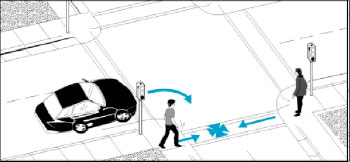 Conflict between pedestrian and right-turning vehicle.
Conflict between pedestrian and right-turning vehicle.
Possible Cause/Problem #2:
Conflict between pedestrian and right-turning vehicle.
- Candidate Countermeasures:
- Provide marked crosswalks and advanced stop lines.
- Improve intersection lighting to improve visibility.
- Remove intersection snow/clutter at the corner to improve visibility and give pedestrian space to stand outside of roadway.
- Install raised median and pedestrian crossing island.
- Reduce right-turn radii.
- Add curb extensions.
- Use a traffic-calming device, such as a raised intersection or raised pedestrian crossing, to reduce vehicle speeds.
- Consider street closure.
- Prohibit right turn on red (RTOR).
- Install warning signs for pedestrians and/or motorists.
- Remove on-street parking from the approaches to crosswalks.
- Install automated pedestrian detection system.
- Add leading pedestrian interval (LPI) to traffic signal system.
- Add advance yield/stop lines 20 to 50 feet before intersection.
- Modify skewed intersections.
- Provide pedestrian accommodations at complex intersections.
- Install push button and adjust signal timing.
- Install puffin crossing.
- Install automated enforcement system.
- Implement driver and/or education program.
Possible Cause/Problem #3:
Substantial number of school children crossing and large turning vehicle movement.
- Candidate Countermeasures:
- Install crosswalk markings.
- Improve intersection lighting.
- Consider using modified T-intersections, intersection median barriers, diverters, or street closures.
- Install curb extensions.
- Install pedestrian crossing islands for wide two-way streets.
- Add exclusive pedestrian phase or leading pedestrian interval.
- Restrict right turn on red (RTOR).
- Prohibit left turns.
- Provide adult crossing guards during school crossing periods, or two guards for wide streets.
- Educate motorists.
- Educate children about safe crossing behavior.
- Provide police enforcement at the intersection.
- Install automated pedestrian detection system.
- Add leading pedestrian interval to traffic signal system.
- Add advance yield/stop lines 20 to 50 feet before intersection.
- Modify skewed intersections.
- Prohibit left turns.
- Implement protected left turn phasing.
- Install push button and adjust signal timing.
- Install pedestrian hybrid beacon (PHB).
- Install rectangular rapid flash beacon (RRFB).
- Implement driver and/or education program.
Possible Cause/Problem #4:
Inadequate sight distance and/or intersection geometrics.
- Candidate Countermeasures:
- Add marking treatments that improve visibility of pedestrian crossing areas.
- Improve intersection lighting.
- Reduce turn radii.
- Install pedestrian crossing islands.
- Remove sight obstructions and/or roadside obstacles (e.g., trees/shrubs, mailboxes, poles, newsstands, trash cans).
- Install motorist regulatory signs and/or pedestrian warning signs (see MUTCD).
- Provide special pedestrian signal phasing (e.g., exclusive protected pedestrian signal interval).
- Prohibit right turn on red (RTOR).
- Prohibit left turns.
- Add on-street parking enhancements.
- Add advance yield/stop lines 20 to 50 feet before intersection.
- Modify skewed intersections.
- Implement protected left turn phasing.
7. Through Vehicle at Signalized Location
The pedestrian was struck at a signalized intersection or midblock location by a vehicle that was traveling straight ahead.
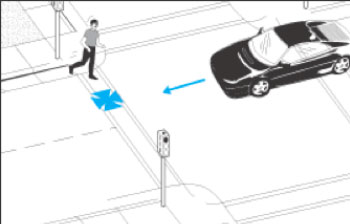 A pedestrian was struck at a signalized intersection or midblock location by a vehicle that was traveling straight ahead.
A pedestrian was struck at a signalized intersection or midblock location by a vehicle that was traveling straight ahead.
Possible Cause/Problem #1:
Pedestrian could not see traffic signal.
- Candidate Countermeasures:
- Install new or larger pedestrian WALK/DON’T WALK and/or audible pedestrian signals.
- Add on-street parking restrictions.
- Install automated pedestrian detection system.
- Add leading pedestrian interval to traffic signal system.
- Modify skewed intersections.
- Prohibit left turns.
- Implement protected left turn phasing.
- Install push button and adjust signal timing.
- Install puffin crossing.
- Implement driver and/or pedestrian education program.
Possible Cause/Problem #2:
Children crossing in school zones.
- Candidate Countermeasures:
- Provide pavement markings and school zone signs.
- Convert to one-way street network (if justified by surrounding area-wide pedestrian and traffic volume study).
- Consider using intersection median barriers, diverters, or street closures.
- Provide curb extensions to reduce crossing distance.
- Use traffic calming devices such as mini-circle or raised intersection to reduce vehicle speeds.
- Provide a raised pedestrian crossing.
- Provide advanced stop lines.
- Install pedestrian signals.
- Provide adult crossing guards, or two guards for wide streets.
- Install school regulatory flashers (e.g., SPEED LIMIT 25 MPH WHEN FLASHING).
- Install pedestrian hybrid beacon (PHB).
- Install rectangular rapid flash beacon (RRFB).
- Provide pedestrian education to students and motorists.
- Increase police enforcement.
- Install automated pedestrian detection system.
- Add leading pedestrian interval to traffic signal system.
- Modify skewed intersections.
- Prohibit left turns.
- Implement protected left turn phasing.
- Install push button and adjust signal timing.
Possible Cause/Problem #3:
Excessive delay to pedestrians prior to getting the WALK interval.
- Candidate Countermeasures:
- Provide pedestrian crossing islands.
- Re-time signal to be more responsive to pedestrian needs (e.g., shorter cycle lengths or convert to fixed-time operation).
- Provide quick-response pedestrian push-buttons or automatic (e.g., microwave or infrared) detectors.
- Install automated pedestrian detection system.
- Add leading pedestrian interval to traffic signal system.
- Prohibit left turns.
- Implement protected left turn phasing.
- Install push button and adjust signal timing.
- Provide pedestrian accommodations at complex intersections.
 Lack of pedestrian compliance with signal WALK phase.
Lack of pedestrian compliance with signal WALK phase.
Possible Cause/Problem #4:
Lack of pedestrian compliance with WALK phase due to other causes.
- Candidate Countermeasures:
- Re-time signal to be more responsive to pedestrian needs (e.g., shorter cycle length).
- Provide adequate WALK and clearance intervals.
- Provide adult crossing guard at school crossings.
- Provide pedestrian and motorist education.
- Install automated pedestrian detection system.
- Add leading pedestrian interval to traffic signal system.
- Modify skewed intersections.
- Prohibit left turns.
- Implement protected left turn phasing.
- Install automated enforcement system.
Possible Cause/Problem #5:
Motorist did not see pedestrian in time to stop.
- Candidate Countermeasures:
- Add marking treatments that improve visibility of pedestrian crossing areas.
- Move bus stop to far side of intersection.
- Improve nighttime lighting.
- Add curb extensions.
- Add pedestrian crossing islands or raised crosswalk.
- Use traffic-calming devices, such as speed tables or a speed-monitoring trailer on streets approaching the intersection if speed is an issue.
- Construct raised intersection.
- Remove sight obstructions such as mailboxes or parked vehicles.
- Remove on-street parking near intersection (e.g., up to 100 ft).
- Install automated pedestrian detection system.
- Add leading pedestrian interval to traffic signal system.
- Modify skewed intersections.
- Prohibit left turns.
- Implement protected left turn phasing.
- Install push button and adjust signal timing.
- Install automated enforcement system.
- Implement driver education program.
Possible Cause/Problem #6:
Motorist ran through a red light at a signalized intersection.
- Candidate Countermeasures:
- Improve lighting.
- Add short all-red interval at signal.
- Increase police enforcement.
- Install camera enforcement.
- Modify skewed intersections.
- Implement driver education program.
8. Walking Along Roadway
The pedestrian was walking or running along the roadway and was struck from the front or from behind by a vehicle.
 A pedestrian walking along the roadway during dark, unlit conditions, in the same direction as vehicular traffic, and was struck from behind by a vehicle.
A pedestrian walking along the roadway during dark, unlit conditions, in the same direction as vehicular traffic, and was struck from behind by a vehicle.
Possible Cause/Problem #1:
Inadequate walking area.
- Candidate Countermeasures:
- Provide a sidewalk on both sides of road.
- Provide an asphalt path or paved shoulder.
- Construct and maintain sidewalks and curb ramps to be usable by people with disabilities.
- Add sidewalk, install bicycle lanes or painted shoulders, reduce number of lanes (e.g., four lanes to three lanes), and add planting strips.
- Improve lighting.
- Improve access to transit.
- Provide pedestrian accommodations at complex intersections.
- Implement pedestrian detours in work zones.
- Improve pedestrian safety at railroad crossings.
- Implement driver and/or pedestrian education program.
Possible Cause/Problem #2:
High vehicle speeds and/or volume.
- Candidate Countermeasures:
- Add sidewalk or walkway.
- Construct and maintain sidewalks and curb ramps to be usable by people with disabilities.
- Increase lateral separation between pedestrians and motor vehicles (e.g., bike lanes or landscape buffers).
- Provide lighting.
- Construct gateway or install signs to identify neighborhood as area with high pedestrian activity.
- Install “Walk on Left Facing Traffic” signs.
- Use speed-monitoring trailers.
- Increase police enforcement of speed limit.
- Improve access to transit.
- Provide pedestrian accommodations at complex intersections.
- Implement pedestrian detours in work zones.
- Improve pedestrian safety at railroad crossings.
- Implement driver and/or pedestrian education program.
Possible Cause/Problem #3:
Inadequate route to school.
- Candidate Countermeasures:
- Provide sidewalks on both sides of road.
- Construct and maintain sidewalks and curb ramps to be usable by people with disabilities.
- Implement traffic-calming methods at selected sites.
- Provide adult crossing guards.
- Involve school groups and PTA in evaluating safe routes to school and promoting education and enforcement.
- Improve access to transit.
- Provide pedestrian accommodations at complex intersections.
- Implement pedestrian detours in work zones.
- Improve pedestrian safety at railroad crossings.
Possible Cause/Problem #4:
Sidewalks are not accessible to all pedestrians.
- Candidate Countermeasures:
- Repair and maintain sidewalks.
- Remove obstacles in sidewalk.
- Build missing sidewalk segments.
- Construct curb ramps.
- Relocate poles and street furniture to provide continuous passage in sidewalk area.
- Enforce parking laws to prevent cars from blocking sidewalks and curb ramps.
- Improve access to transit.
- Implement access management design solutions.
- Provide pedestrian accommodations at complex intersections.
- Implement pedestrian detours in work zones.
- Improve pedestrian safety at railroad crossings.
9. Working/Playing in Road
A vehicle struck a pedestrian who was: (1) standing or walking near a disabled vehicle, (2) riding a play vehicle that was not a bicycle (e.g., wagon, sled, tricycle, skates), (3) playing in the road, or (4) working in the road.
 Worker struck in roadway.
Worker struck in roadway.
Possible Cause/Problem #1:
Worker, policeman, etc, struck in roadway (arterial street).
- Candidate Countermeasures:
- Improve lighting and retroreflective materials on workers.
- Improve traffic control measures (e.g., signs, markings, cones, barricades, and flashers) warning motorists of workers’ presence.
- Increase worker safety training.
- Increase police enforcement of speed limits in work zones.
- Provide better physical separation/protection from motor vehicles.
- Add on-street parking restrictions.
- Implement pedestrian detours in work zones.
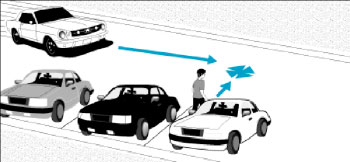 A pedestrian was struck while playing in the roadway.
A pedestrian was struck while playing in the roadway.
Possible Cause/Problem #2:
Pedestrian was struck playing on foot or on play vehicle (e.g., skateboard, wagon, sled, in-line skates) on local/collector street.
- Candidate Countermeasures:
- Provide accessible sidewalks or walkways on both sides of street.
- Improve lighting.
- Introduce traffic-calming measures (e.g., street narrowing, speed humps).
- Convert streets to a shared street or use signs to identify neighborhood as area with high levels of pedestrian activity.
- Consider street closures (full or partial) or using diverters.
- Implement pedestrian and motorist education programs.
- Provide community park/playground.
- Add on-street parking enhancements.
- Implement access management design solutions.
Possible Cause/Problem #3:
Vehicle speeds are excessive on local street.
- Candidate Countermeasures:
- Narrow streets and/or travel lanes.
- Convert to driveway link/serpentine street.
- Install traffic-calming devices such as chicanes, mini-circles, speed humps, and/or speed tables.
- Use speed-monitoring trailers in conjunction with police enforcement.
- Add on-street parking enhancements.
- Implement access management design solutions.
- Install automated enforcement system.
- Implement driver education program.
- Implement pedestrian education program.
Possible Cause/Problem #4:
Walking to/from disabled vehicle.
- Candidate Countermeasures:
- Provide sidewalks, walkways, or paved shoulders.
- Provide adequate nighttime lighting.
- Educate drivers about what to do if a vehicle becomes disabled.
- Provide motorist assistance program.
Possible Cause/Problem #5:
Working on or standing by a disabled vehicle.
- Candidate Countermeasures:
- Provide paved shoulders.
- Provide adequate nighttime lighting.
- Educate drivers about what to do if a vehicle becomes disabled.
- Provide motorist assistance program.
10. Non-Roadway (Sidewalk, Driveway, Parking Lot, or Other)
The pedestrian was standing or walking near the roadway edge, on the sidewalk, in a driveway or alley, or in a parking lot, when struck by a vehicle.
Possible Cause/Problem #1:
Pedestrian was struck while waiting to cross roadway, standing at or near curb.
- Candidate Countermeasures:
- Provide accessible sidewalks/walkways and crosswalks.
- Provide sidewalk buffer (bike lane or landscape strip).
- Improve nighttime lighting.
- Reduce curb radii to slow turning cars.
- Use adult crossing guard.
- Implement driver and/or pedestrian education program.
- Increase speed enforcement .
- Implement access management design solutions.
- Provide pedestrian accommodations at complex intersections.
- Prohibit left turns.
 A pedestrian was struck in parking area.
A pedestrian was struck in parking area.
Possible Cause/Problem #2:
Pedestrian was struck in parking lot, driveway, private road, gas station, alley, etc.
- Candidate Countermeasures:
- Maintain level sidewalk across driveway area.
- Move sidewalk farther back so that driver will have more time to stop for a pedestrian crossing a driveway.
- Improve nighttime lighting.
- Remove landscaping or other visual obstructions near driveways.
- Implement pedestrian and motorist education programs.
- Redesign or re-stripe parking lot to provide clear pedestrian path across parking lot.
- Build/improve local parks for activities that appeal to children and teens.
- Implement access management design solutions.
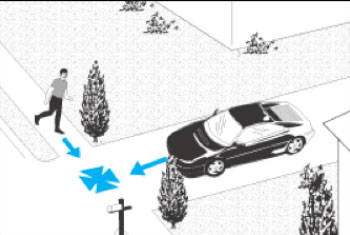 A vehicle struck pedestrian while exiting a driveway or alley.
A vehicle struck pedestrian while exiting a driveway or alley.
Possible Cause/Problem #2:
Vehicle entered or exited a driveway or alley and struck pedestrian.
- Candidate Countermeasures:
- Provide sidewalk or walkway .
- Maintain level sidewalks across driveways or alleys.
- Provide clear walking path across driveway .
- Remove unneeded driveways and alleys.
- Remove sight obstructions (e.g., trim hedges or lower fencing).
- Narrow driveways and reduce turning radii.
- Add adequate planting strip or sidewalk separation.
- Provide advance warning signs for drivers.
- Implement access management design solutions.
- Prohibit left turns.
- Implement driver and/or pedestrian education program.
11. Backing Vehicle
The pedestrian was struck by a backing vehicle on a street, in a driveway, on a sidewalk, in a parking lot, or at another location.
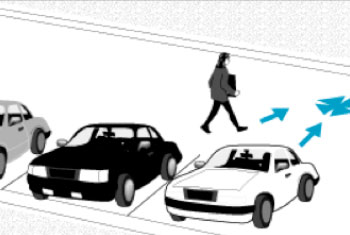 A pedestrian was struck by a backing vehicle in a parking lot.
A pedestrian was struck by a backing vehicle in a parking lot.
Possible Cause/Problem #1:
Pedestrian struck by backing vehicle.
- Candidate Countermeasures:
- Provide clearly delineated walkways for pedestrians in parking lots.
- Relocate pedestrian walkways.
- Improve nighttime lighting.
- Remove unneeded driveways and alleys.
- Remove landscaping or other sight obstruction near driveways.
- Provide curb extensions or raised pedestrian crossings to improve the visibility of pedestrians to backing motorists.
- Eliminate, modify, or relocate parking if feasible.
- Enhance pedestrian education.
- Enhance motorist education.
- Provide auditory backing alert on vehicles.
12. Crossing Expressway
The pedestrian was struck while crossing a limited-access expressway or expressway ramp.
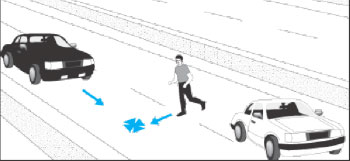 A pedestrian was struck while crossing a limited-access expressway.
A pedestrian was struck while crossing a limited-access expressway.
Possible Cause/Problem #1:
Disabled vehicle (pedestrian crosses expressway to seek help).
- Candidate Countermeasures:
- Install/upgrade roadway lighting.
- Educate drivers on what to do if a vehicle is disabled.
- Increase police surveillance.
- Provide motorist assistance program.
- Improve access to transit.
- Provide pedestrian accommodations at complex intersections.
13. Miscellaneous
Finally, there are a number of other pedestrian crash types, such as:
- Intentional crashes.
- Driverless vehicle incidents.
- Pedestrian struck after a vehicle/vehicle collision.
- Pedestrian struck by falling cargo.
- Emergency vehicle striking a pedestrian.
- Pedestrian standing or lying in the road.
Possible Cause/Problem #1:
Pedestrian lying in road.
- Candidate Countermeasures:
- Install or upgrade nighttime lighting.
- Increase police enforcement and surveillance.
- Provide taxi rides home from bars.
- Install automated enforcement system.
Possible Cause/Problem #2:
Emergency vehicle-related.
- Candidate Countermeasures:
- Install/upgrade lighting.
- Provide public education.
- Increase police surveillance.
Possible Cause/Problem #3:
Pedestrian falls from vehicle.
- Candidate Countermeasures:
- Pass/enforce laws and provide education programs against riding in back of pickup trucks.
- Increase police enforcement of teens “vehicle surfing.”
- Plan and design streetcar line.

